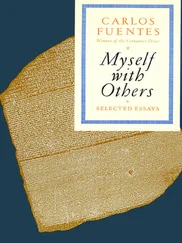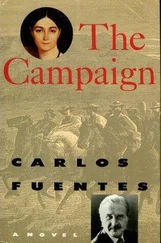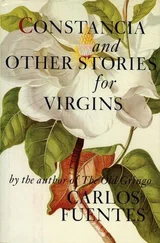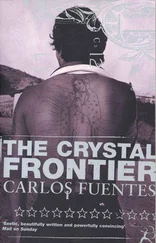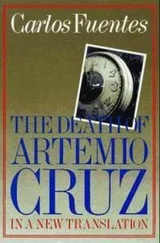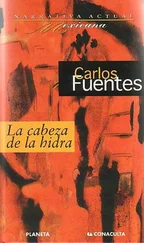Had Harry informed on his left-wing comrades to McCarthy?
And finally, above all, what had become of Jorge Maura? Was he alive, was he dying, had he already died? Did he find God? Had God found him? Had Jorge Maura sought for spiritual well-being so strenuously only because he’d already found it?
Arriving at that final mystery, the fate of Jorge Maura, Laura Díaz stopped, granting her lover a privilege she would soon grant to all the other protagonists of the years with Laura Díaz: the right to carry a secret to the grave.
When the third Santiago was murdered in the Plaza of the Three Cultures, Laura presumed that the young, pregnant widow, Lourdes Alfaro, would continue to live with her. Lourdes transformed her grief into a decision to honor — twice over — the memory of Santiago. In April 1969 she gave birth to a boy, who was of course named Santiago, the fourth to be named after the Greater Apostle, witness of the agony and transfiguration of the victims: the Santiagos, “sons of the lightning,” descendants of Christ’s first disciple, executed by the power of Herod and saved for love, home, and the memory of Laura Díaz.
Lourdes did her duty as a mother and — with the infant Santiago in a rebozo on her back — she organized demonstrations to seek the release of political prisoners from 1968, helped other young Tlatelolco widows like herself who had small children who needed nursemaids, medicine, care, and also, Lourdes said to Laura, the living memory of their fathers’ sacrifice. Of course, there were times when the situation was reversed and the fathers were widowers whose young student wives had fallen in Tlatelolco.
Thus a union of survivors of October 2 came into being. Lourdes met, came to know, and fell in love with a young man who was twenty-six years old. Jesus Anibal Pliego, who was starting out as a filmmaker and had managed to shoot bits and pieces — shadowy fields, blood-red filters, echoes of machine-gun fire — of the night at Tlatelolco. That same night, Jesus Anibal’s young wife had also died, and the widower, a tall, dark, curly-headed young man with a radiant smile and eyes, was left with a little girl just a few months old, Enedina, who was in the same day-care center Lourdes used for her son, the fourth Santiago in the line of Laura Díaz.
“I have something to tell you, Laura,” Lourdes blurted out after pussyfooting around for several weeks. Lauras, of course, had already guessed everything.
“You don’t have to tell me anything, dear girl. You’re like my daughter, and I understand everything. I couldn’t think of a better match for you than Jesús Aníbal. You’ve got so much in common. If I were old-fashioned, I’d give you my blessing.”
They had something more than love in common: work. Lourdes, who had learned a great deal at Laura’s side, could now work more and more with Jesus Aníbal as his photographic assistant. But what Lourdes had to tell Laura was that she, her husband, and the two children — Enedina and Santiago the Fourth — were going to live in Los Angeles. Jesus Aníbal had gotten an excellent offer from an American movie company: in Mexico he had few chances to work because the Díaz Ordaz government had confiscated his Tlatelolco films.
“You don’t have to explain anything, mi amor. I know how things are.”
The apartment on Plaza Rio de Janeiro was empty.
The fourth Santiago barely left a trace in the memory of his great-grandmother. Just saying that word fills me with pride, satisfaction, consolation, and disconsolation, makes me afraid and makes me sad, convinces me in a happy way that I’ve finally managed to kill vanity — I’m a great-grandmother! — but also that I’ve managed to revive death, my own death forever accompanying that of each Santiago — the one shot in Veracruz, the one who died in Mexico City, the one murdered in Tlatelolco, and now the one who’s going to Los Angeles, my little bracero— now I’m going to laugh — my little wetback whom I’ll never get to dry with the towels my mother Leticia gave me when I married. How certain things last! …
Living alone was no problem for Laura Díaz, She kept herself agile, busy, deriving pleasure from little things, like making the bed, washing and hanging out clothes, keeping herself “snappy,” as she said to Orlando, shopping at the new Aurrerá supermarket, just as she’d once gone, a young bride, to the old Parián market on Avenida Alvaro Obregón. Late in the day, she’d inherited from her mother Leticia a taste for cooking. She rescued old Veracruz recipes — rice and beans, the wonderful shredded beef of ropa vieja, tamales in the coastal style, stuffed crabs, squid in its own ink, snapper swimming in a sea of onions, olives, and tomatoes, strong, hot coffee the way they used to serve it in the Café de la Parroquia, hot coffee to keep out the heat, as Doña Leticia. Kelsen de Díaz recommended. And as if it had just arrived from another celebrated café, the one in Almendares Park in Havana, the cloyingly sweet tocinillo del cielo along with the full gamut of Mexican sweets which Laura would buy at the Celaya candy store on Avenida Cinco de Mayo — the bicolored jamoncillos, the marzipans and glazed sweet potatoes; the peaches, pineapples, figs, cherries, and crystallized quince — and for her breakfasts, chilaquiles in green sauce, huevos rancheros, fried tortillas with chicken, lettuce, and fresh cheese, “divorced” eggs (red and green), and, again, all the different kinds of Mexican breads: rolls, biscuits, white bread, the sugar cookies, the conch shells, and chilindrinas.
She classified her negatives, attended to requests to buy prints of her classic photographs, prepared books, and dared to request prefaces from new writers — Salvador Elizondo, Elena Poniatowska, Margo Glantz, and the youngsters of the Onda movement, José Agustín and Gustavo Saínz. Diego Rivera had died in 1957; Rodriguez Lozano, María Izquierdo, and Alfonso Michel had died, artists she’d known and who had inspired her (the pure, brutal blacks, whites, and grays of the first, the false naivete of the second, the wise shock of each color in the third), and the only two who’d survived, antagonistic but huge, Siqueiros the Big Colonel with fists raised against the celebratory velocity of the world in motion, and Tamayo, handsome, shrewd, and silent, his head just like the volcano Popocatépetl. There wasn’t much to cling to. Unless it was disappearing memory and will. One after another, the guardians of shared memories were disappearing.
One dry, no longer rainy afternoon during the beautiful Mexican autumn, someone knocked at Laura’s door. When she opened it, she had a hard time identifying the woman in black, the first thing Laura noticed being the dark suit in expensive good taste, as if to call attention to a figure that was attractive without needing attention, such was the faded aspect of the face with no memorable features, not even a trace of lost beauty. The beauty innate in all young women. Even in ugly ones. Here, instead, was an evident pride, concentrated, painful, submitted —that word emanated from the lady’s eyes, uncomfortable eyes, uncertain and troubled beneath thick brows as the unknown visitor emitted an “Oh!” as submissive as the rest of her person and shifted her eyes to the floor in alarm.
“My contact lens fell out,” said the stranger.
“Well, let’s find it.” Laura Díaz laughed.
The two of them, on all fours, felt around on the entry way floor until Laura touched the tiny piece of moist lost plastic with the tip of her index finger. But with her other hand she touched a distant but familiar flesh as she presented the saved lens to Magdalena. Ayub Longoria. I’m Danton’s wife, your daughter-in-law, the woman explained, standing up but not daring to put the lens back in its place while Laura invited her in.
Читать дальше


